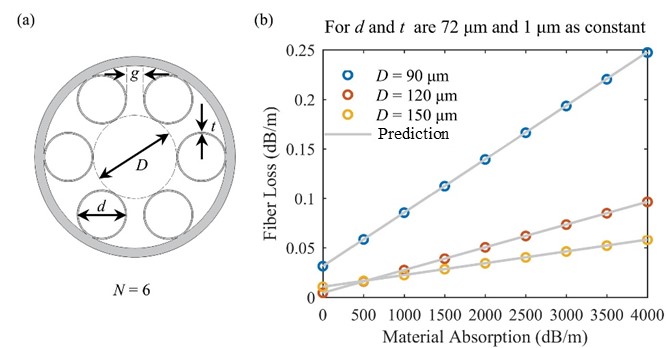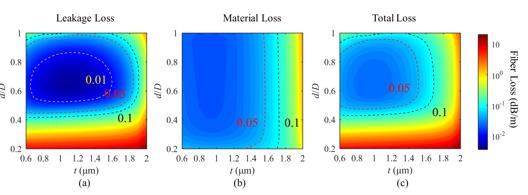
In the last few years, the anti-resonant hollow-core fiber (AR-HCF) has captured massive attention for its low-loss and broadband transmission properties. As the majority of model power is guided in the hollow core, AR-HCFs are well known for a significantly reduced material loss. However, in spite of a quick development of AR-HCF at highly absorptive wavelengths, e.g. mid-infrared and deep ultraviolet, our understanding of material loss of AR-HCF and properties lags behind the experimental demonstration and successful applications.
Recently, the research group in Shanghai Institute of Optics and Fine Mechanics (SIOM), Chinese Academy of Sciences (CAS), reported the first semi-analytical model of material loss in AR-HCF. The result was published in Optics Express.
The possibility of manufacturing low-loss hollow core "microstructured" fibers was first identified in the early 1990's, which has been attracting continuous research to overcome the limitations of conventional optical fiber by having the light travel through a hollow core. The significantly large core design makes AR-HCF quickly stand out for excellent performance in terms of low leaky and material losses.
Intuitively, the ratio of power in host material had been ‘naturally’ preferred to estimate the material loss of hollow-core fiber, which sometimes could deviate by over 20% from numerical simulations.
Researchers from SIOM revisited the problem from the fundamental and extended the equivalent current method used by Snyder and Love in dealing with traditional optical fiber material loss in 1980's to the hollow-core fiber. Under assumption of linearly polarized mode for a large-core AR-HCF, a semi-analytical formula of material loss of AR-HCF was strictly derived with high accuracy confirmed by finite-element method (FEM).
By using the new model, the optimal design of silica-based AR-HCF at highly absorptive wavelengths was thoroughly discussed and 24.03 dB/km was predicted as the limit of attenuation for AR-HCF at 4 μm wavelength.
This work provides practical guidance to develop low-loss AR-HCF at highly absorptive wavelengths, including both the vacuum UV and mid/far-infrared spectral regions.
This work was supported by the National Natural Science Foundation of China, the Natural Science Foundation of Shanghai and the Key Research Program of Frontier Sciences, CAS.

AR-HCF model for simulation and the total losses of AR-HCF of three core diameters. (Image by SIOM)

Calculated loss of a silica-based 6-capillary AR-HCF (Image by SIOM)

86-10-68597521 (day)
86-10-68597289 (night)

52 Sanlihe Rd., Xicheng District,
Beijing, China (100864)

